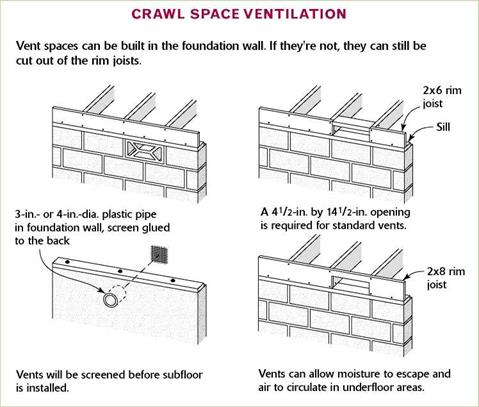VENTING A CRAWL-SPACE FOUNDATION—OR NOT

Until recently, most crawl-space foundations were built with vents to promote air circulation and help prevent damaging levels of moisture from building up beneath the house. In northern states, builders often install vents that can be closed in the winter to keep out cold air. The same is done on the Oregon coast to keep out moist air. Many local building codes require crawl-space ventilation, so be sure to check with your building department to find out which requirements are in effect.
Codes requiring vents usually stipulate that a vent be installed 2 ft. from each corner of the foundation and every 6 ft. on at least three sides of the building. For appearance’s sake, most builders try to leave vents off the front of the building.
If you need to install crawl-space vents, there are several ways to do so. Some factory-made vents are designed for installation in openings formed in a poured concrete wall. Others are sized to fit in concrete block walls. For a simple, inexpensive, and attractive vent, cut sections of 3-in.- or 4-in.-dia. plastic pipe and put them in the foundation wall forms before pouring the concrete. Use adhesive to secure pieces of 1/4-in. wire mesh (also called hardware cloth) over indoor pipe sections to keep out animals. Still another way to ventilate a crawl space is by cutting openings in the rim joists, as shown in the illustration at right.
Unvented Crawl Spaces
Based on relatively new research, builders in some regions are beginning to eliminate vents and treat crawl spaces like small basements. The idea behind this type of construction is
that you start with a dry crawl space and keep it that way. Sealing off a wet crawl space can lead to a moldy disaster, but it is possible to create a warm, dry crawl space by preventing moisture and air from entering. Follow the good drainage guidelines explained in the sidebar on p. 54.
Dirt floors must be sealed with a sheet of 6-mil plastic that laps up onto the foundation and is fastened against it with mastic. Rigid insulation should be used on foundation walls, eliminating the need for insulation in the joist spaces under the floor. With the help of a heating contractor, you can even supply a crawl space with a small heating duct to help keep it dry. You can create access to the crawl space through a trap door framed in the floor of a closet.






Leave a reply